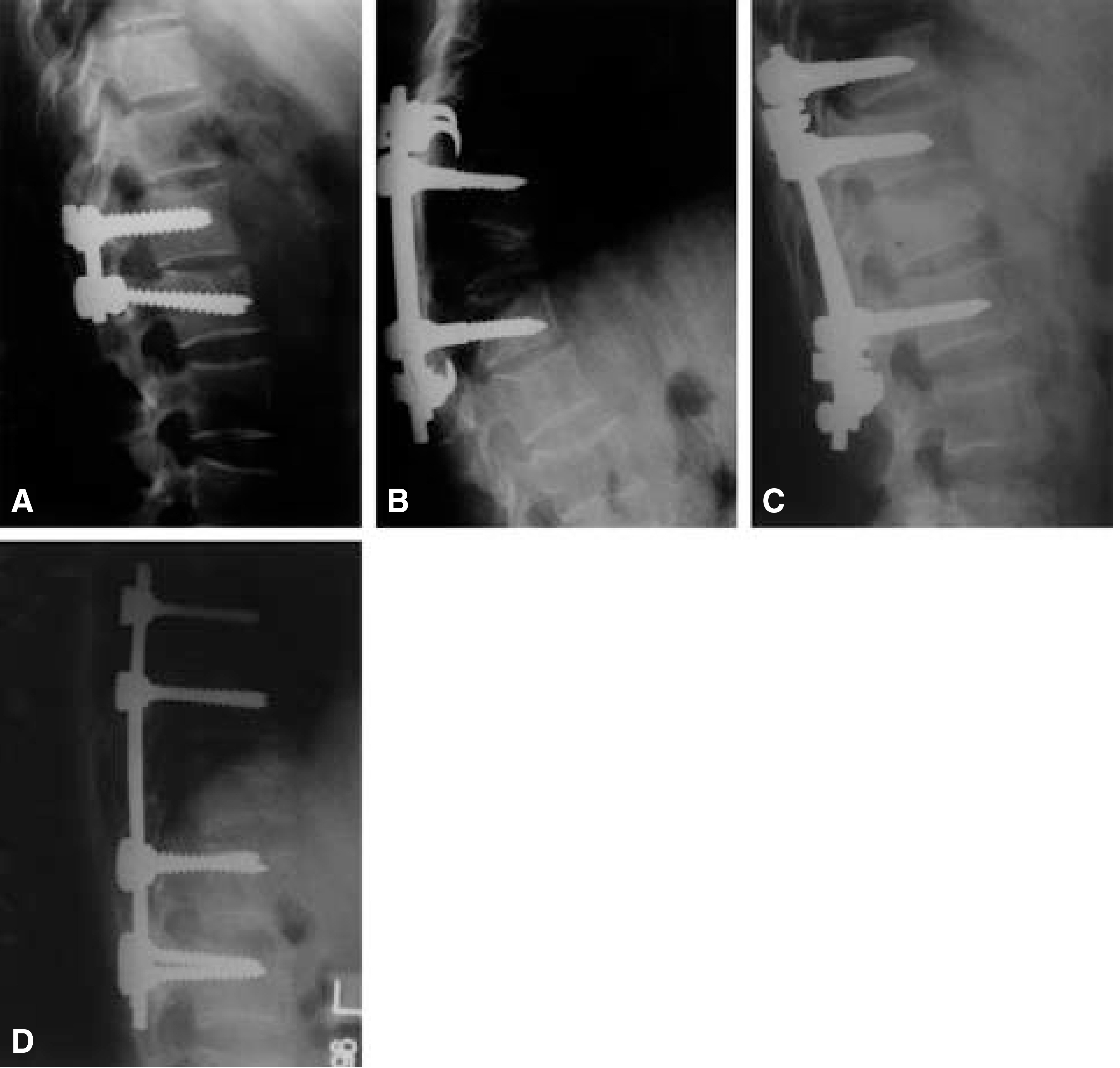J Korean Soc Spine Surg.
2001 Sep;8(3):423-427. 10.4184/jkss.2001.8.3.423.
Posterior Instrumentation of Thoracolumbar Fracture
- Affiliations
-
- 1Department of Orthopedic Surgery, Hallym University College of Medicine, Seoul, Korea. jylee@hallym.or.kr
- KMID: 2209766
- DOI: http://doi.org/10.4184/jkss.2001.8.3.423
Abstract
- The thoracolumbar spine remains the most common site of vertebral column injuries. Surgical stabilization using posterior instrumentation for thoracolumbar injuries offers several advantages such as nearly anatomical reduction of fractures, protection of neurologic function and most important early ambulation of the patient, and so major benefits of early fixation are decreased hospital stay, early rehabilitation, and prevention of deformity and pain. The treatment of fracture-dislocation of the thoracolumbar spine has been progressively improved over the past decades and recently a lot of posterior instrumentation has been introduced to improve fixation of the involved vertebrae three dimensionally and short segmental fixation as possible.
Figure
Cited by 2 articles
-
The Effect of Vertebral Wedge Angle to the Change of Kyphotic Angle by the Posterior Instrumentation Method in Thoracolumbar Spine Fracture
Seok-Kon Kim, Myung-Ho Kim, Sung-Churl Lee, Sang-Hyuk Min, Jin-Won Lee
J Korean Soc Spine Surg. 2009;16(3):160-166. doi: 10.4184/jkss.2009.16.3.160.Efficiency of Implant Removal for Treatment of the Thoracolumbar Unstable Fractures - Multi Segments Fixation ∙ Single Segment Fusion -
Heui-Jeon Park, Young-Jun Shim, Wan-Ki Kim, Tae-Yeon Cho, Sung-Min Kwon
J Korean Soc Spine Surg. 2011;18(3):103-110. doi: 10.4184/jkss.2011.18.3.103.
Reference
-
1). Argenson C, de Peretti F, Lacour C, Puch JM, Cambas PM, Hovorkca E. Burst fractures of the thoracolumbar junction treated by the “modular construct” type of the Cotrel-Dubousset device. Presented in European spinal deformities society, Lyon, France. 1992.2). Bohlman HH, Bahniuk E, Raskulinecz G, Field G. In Mechanical factors affecting recovery from incomplete cervical cord injury: A preliminary report. Johns Hopkins Med J. 145:115–125. 1979.3). Boucher HH. A method for spinal fusion. J Bone Joint Surg. 41-B:248–259. 1957.4). Cammisa FP, Eismont FJ, Green BA. Dural laceration occuring with burst fracture and associated laminar fracture. J Bone Joint Surg. 71-A:1044–1052. 1989.5). Cotrel Y, DuBousset J. New segmental posterior instrumentation of the spine. Proceedings at the 19th Annual Meeting of the. Scoliosis Research Society;Orlando. 1984.6). Delamarter RB, Sheman J, Carr JB. Pathophysiology of spinal cord injury: Recovery after immediate and delayed decompression. J Bone Joint Surg. 77A:1042–1049. 1995.
Article7). Denis F. The three column spine and its significance in the classification of acute thoracolumbar spinal injuries. Spine. 8:817–831. 1983.
Article8). Dickson JH, Harrington PR, Erwin WD. Results of reduction and stabilization of the severely fractured thoracic and lumbar spine. J Bone joint Surg. 59-A:143–153. 1977.
Article9). Edwards CC, Levine AM. Complications associated with posterior instrumentation in the reament of toracic and lumbar injuries. Garfin SR, editor. Complications of spinal surgery. Baltimore: Wilkins;p. 164–199. 1989.10). Edwards CC, Levine AM. Early rod-sleeve stabilization of the injured thoracic and lumbar spine. Orthop Clin North Am. 17:121–145. 1986.
Article11). Fredrickson BE, Mann MS, Yuan HA, Lubicky JP. Reduction of intracanal fragment in experimental burst fracture. Spine. 13:267–271. 1988.12). Kaneda K, Ito M, Taneichi H. Osteoporotic posttraumatic vertebral collapse with neurologic deficits of the thoracolumbar spine. Presented in 6th IMAST, Vancouver, B.C., Canada. 1999.13). Karlson MK, Hasserius R, Sundgren P, Redllund-Joh-nell I, Ohlin A. Remodelling of spinal canal deformed by trauma. J Spine Dis. 10:157–161. 1997.14). Keene JS, Fischer SP, Vanderby R, Drummond DS, Turski PA. Significance of acute posttraumatic bony encroachment of the neural canal. Spine. 14:799–802. 1989.
Article15). Kostuik JP. Anterior spinal cord decompression for lesions of the thoracic and lumbar spine, techniques, new methods of internal fixation results. Spine. 8:512–531. 1983.
Article16). Krengel WF III, Anderson PA, Henley MB. Early stabilization and decompression for incomplete paraplegia due to thoracic level spinal cord injury. Spine. 18:2080–2087. 1993.17). McBride GG. Cotrel-Kubousset rods in spinal fractures. Paraplegia. 27:440–449. 1989.18). Park IH, Lee KB, Park MR, Lee JY, Rhee DY. Treatment of the unstable thoracolumbar fractures using Cotrel-Dubousset instrumentation. J of Korean Ortho Surg. 25(1):123–131. 1990.19). Roy-Camile R, Saillant G, Mazel C. Internal fixation of the lumbar spine with pedicle screw plating. Clin Orthop. 203:180–191. 1988.20). Sasso RC, Cotler HB. Paosterior instrumentation and fusion for unstable fractures and fracture-dislocations of the thoracic and lumbar spine: A comparative study of three fixation devices in 70 patients. Spine. 18:450–460. 1993.21). Steven RG, Alexander RV. Orthopaedic Knowledge Update Spine. AAOS, 208-215. 1997.
- Full Text Links
- Actions
-
Cited
- CITED
-
- Close
- Share
- Similar articles
-
- Clinical analysis of Posterior Spinal Instrumentation in Unstable Thoracolumbar Fracture and Fracture Dislocation
- Treatment of Unstable Fracture of the Thoracolumbar Spine Using Kaneda Instrumentation
- Posterolateral Decompression and Posterior Instrumentation in Lumbar and Thoracolumbar Burst Fracture with Neurologic Deficit
- Clinical Results of Segmental spinal instrumentation in Unstable Fracture and Fracture - Dislocation of the Thoracolumbar Spine
- Change of Canal Compromise After Ligamentotaxis in Thoracolumbar Burst Fracture


